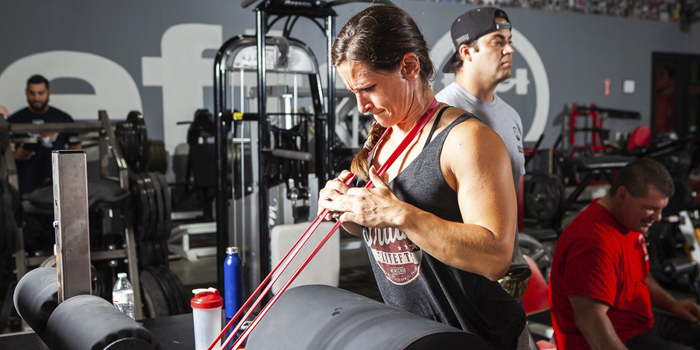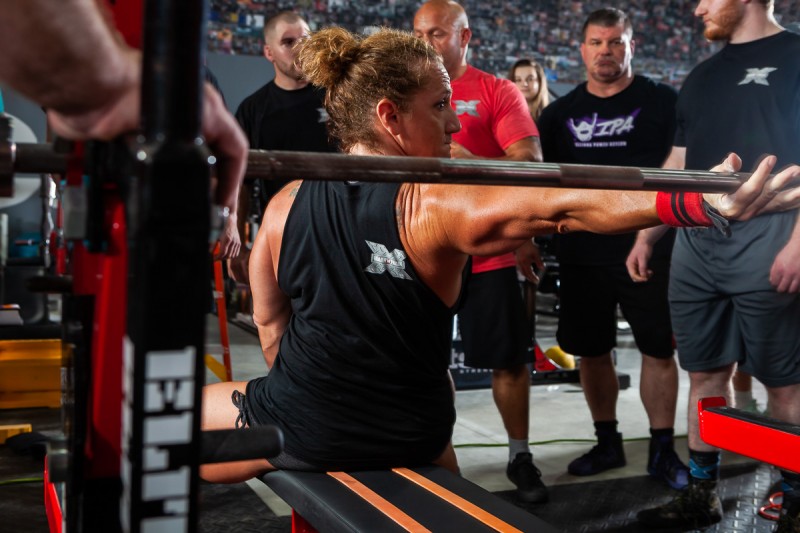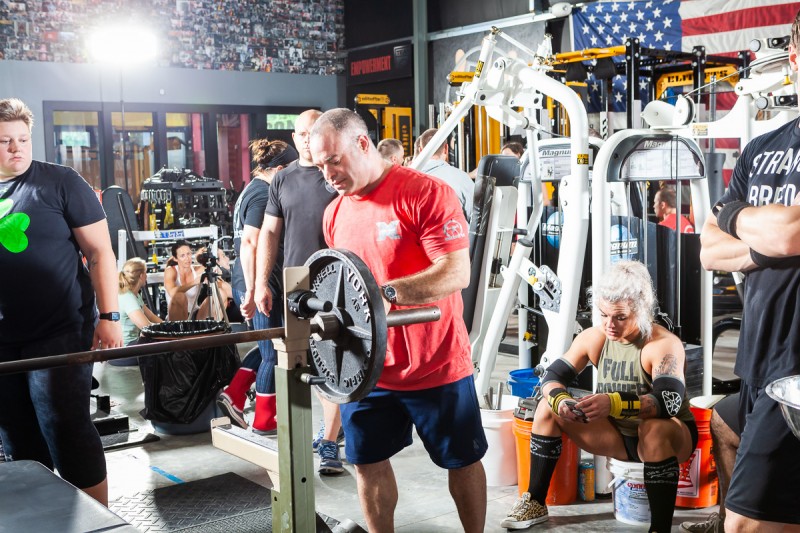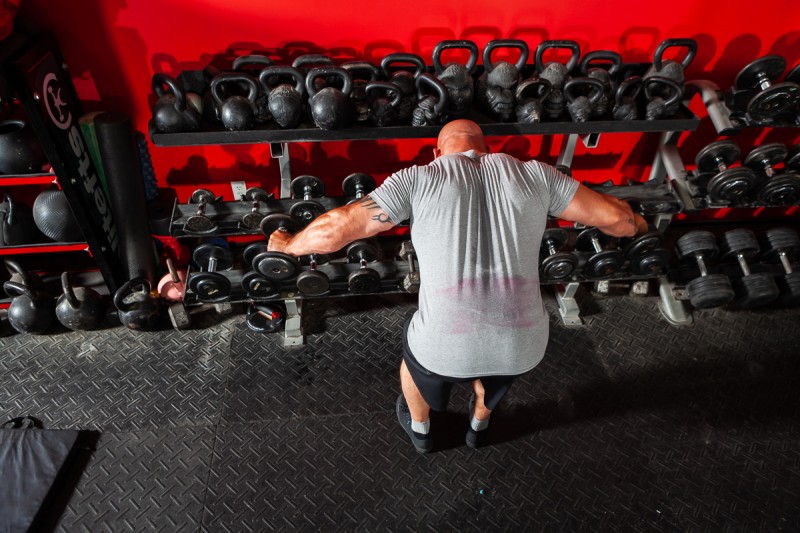
“If you do what you’ve always done, you’ll get what you’ve always gotten.” — Tony Robbins
The above is true of training. What works now won’t work forever. The training you did to get a 220-pound bench press is not the same as what was required to hit 315 pounds. Likewise, progressing to 405 pounds. will require different methods. The principle of progressive overload dictates that training has to get harder over time. However, just doing more and working harder takes you only so far. As you become more advanced, the training adjustments required to grind out marginal gains become more nuanced. Manipulating volume, frequency, and intensity are the variables most often explored by coaches and athletes. These are undoubtedly effective strategies. There are other ways to vary your training to maximize progress though. One often overlooked, or at least misunderstood variable is exercise selection and variation.
Strength athletes tend to do a better job of making smart choices with exercise selection and how to sequence exercises from phase to phase. Bodybuilders and recreational lifters concerned with hypertrophy, however, tend to rely on guesswork, broscience, and fads to determine what comes next. This approach leaves a lot of gains on the table and results in many a confused lifter becoming increasingly frustrated with their lack of progress.
RECENT: Maximize Effective Volume and Minimize Junk Volume (with Program Sample)
In hypertrophy training, variety is a key element in a smart training plan. It is clear that to fully stimulate a muscle, you need to work it across its full contractile range and from different angles. Research indicates that even at equivalent training volumes, using multiple exercises is more effective than a single exercise at stimulating a muscle. This is what caused the muscle confusion trend. Muscle confusion claims that by constantly changing your workouts, you “confuse” your muscles, and they have to work harder, which results in better gains. The idea that muscles get confused is nonsense.
Although you cannot trick or confuse your muscles, you can provide a varied stimulus, which maximises your gains in strength and size. A successful training programme is built around a core group of key exercises that you rotate over several phases of training.
Your exercise variation shouldn’t be haphazard or based on the latest fad exercise that some guru is promoting. Instead, it should fit into your overall plan, complement what has gone before, potentiate what follows, and have a specific purpose. This is where strategic variation comes in. Strategic variation is the art of rotating the exercises in your program to yield the best results.
This variety doesn’t have to happen within one training session, though. Instead, it should occur over the medium term—over the course of a training week and from one phase of training to the next. By rotating exercises for a specific movement pattern or a muscle group, you minimize the “staleness” that occurs from always hitting the exact same exercises over and over.
To review the lifecycle of exercise variation, let’s use these points identified by Paul Carter and Christian Thibaudeau in their excellent book, the Maximum Muscle Bible:
- A new movement is added or changed in execution.
- This then creates a new stimulus.
- Over the next few weeks, you gain strength and neural efficiency in the movement.
- As you adapt, efficiency becomes maximized, and strength gains slow down.
- Once efficiency is maximized and the stimulus decreases, fatigue increases in relation to those factors.
Consequently, once stage five is reached and continued for a few weeks, the return on investment of that exercise constantly diminishes, whereas the toll it is taking on your body constantly increases. At this point, you should strategically change the exercise to avoid injury and to continue effective muscle building training.
How Often Should You Vary Exercises?
Although varying exercises is important for muscle growth, doing it too frequently can be counterproductive. You need to allow enough time for you to master the movement pattern of a specific exercise to be able to sufficiently overload it and provide a growth stimulus. Switching exercises every week doesn’t allow you to do this. It takes time for your body to adapt to a stimulus. This isn't on the scale of days or even weeks but rather several months.
Thus, rotating exercises every 4-12 weeks or so is a good idea. My personal preference is to retain your big foundational exercise selections for the duration of a block of training (12-16 weeks on average). To provide a novel stimulus for the muscle and to keep your training interesting, rotate accessory exercises every 4-6 weeks. In practice, this will look something like this for back training:
Weeks 1-4
- Pull-ups
- Bent Over Rows
- Seated Face Pulls
Weeks 5-8
- Pull-ups (adjust set/rep scheme to provide some novelty)
- DB Single Arm Rows
- Straight Arm Pulldowns
Weeks 9-12
- Pull-ups (adjust set/rep scheme again)
- Cable Low Rows
- Supinated Lat Pulldowns
When you are planning your training, I suggest you pick 2-3 exercises per body part as I have in the above back training example. Train these with sufficient volume to grow and then rotate them when you transition into your next training phase.
Phase Potentiation
Potentiation is the increase in the strength of nerve impulses along pathways that have been used previously, either short-term or long-term. Phase potentiation is, therefore, the process of sequencing successive blocks of training to potentiate each other. If you achieve this, it delivers superior results in strength and mass.
Although differences from one phase to the next will largely revolve around changes in volume and intensity, exercise selection is also a component of the phase potentiation process. Intelligent exercise variation allows you to gain strength and muscle faster.
When it comes to strength, you will likely progress through your program in a linear fashion, from lighter weights and higher reps to heavier weights and lower reps across a series of phases. Likewise, your exercise selection should change in this timeframe. For example, a powerlifter would go from less specific exercise variants to more competition specific lifts. A practical example of how this might go for the bench press is as follows:
Phase 1
- Bench Variation - DB Bench Press
- Triceps Assistance – Dips
Phase 2
- Bench Variation – Touch N’ Go Bench
- Triceps Assistance – Close Grip Board Press
Phase 3
- Bench Variation – Competition Style Paused Bench
- Triceps Assistance – Close Grip Bench Press
When it comes to hypertrophy, the prevailing evidence indicates that the training volume is a primary driver of progress. So, it is important to sequence phases of training together that allows you to progressively overload via volume. Doing more sets and reps is the default setting, but exercise selection can increase the total work performed.

Less Hardcore, More Results
We all know that compound lifts are the cornerstone of an effective program. This does not mean they have to be done exclusively, though.
This is especially the case when you are trying to progressively increase volume. Constantly adding in extra sets of squats or deadlifts is brutal. Eventually, it becomes unsustainable for most. Those who can achieve it become reliant on exotic pre-workout blends, psych-up routines, nose tork, and loud music. Even the hardiest of lifters will eventually pay the price for being up to their eyeballs on stimulants. Although their mindsets are admirable, they are not optimal. Instead, forget about appearing hardcore, and focus on results. Quit being a stimulus junkie, and become a progress junkie. When volume is the name of the game, exercise variation can be your key strategy.
Adding in leg presses or leg extensions for additional quad work is a better choice than adding in more squats even. They add training volume for the quads, save the lower back, and reduce the amount of psychological arousal required to experience a training effect. Likewise, leg curls and back extensions can help to increase the volume without being so taxing as a deadlift marathon. A time when you will welcome the benefits of these “sissy” exercises.
Remember, you don’t get bonus points for suffering more. Results are what matter so, pick exercises that achieve them as efficiently as possible. If this means doing some “fluffier” exercises, swallow your pride and enjoy the rewards.
Strategic Range of Motion Variation
Another way to increase your training volume/workload is to increase the range of motion (ROM) for a given lift.
Work = force x distance
Simply by increasing your ROM from one phase to the next, you will increase the total work performed. This also increases your total time under tension. Even with the same sets and reps, your total training volume can significantly increase using this strategy. So, it is an effective approach for muscle gain. An example of how you could structure this is as follows:
Phase 1
- Rack Pulls
Phase 2
- Deadlift
Phase 3
- Deficit Deadlift
Picking Exercises to Match the Goal of a Phase of Training
This point continues on the theme that achieving higher training volumes is beneficial for hypertrophy. As a consequence, I often suggest a reverse linear periodization scheme to clients whose sole aim is more muscle mass. In this scheme, they go from higher intensities (%1RM) and lower volumes to lower intensities and higher volumes. Following this plan means they overload on the key training variable (volume) responsible for hypertrophy.
A typical template looks like this:
Phase 1 – Mostly sets of 6-10 reps
Phase 2 – Mostly sets of 10-12 reps
Phase 3 – Mostly sets of 15+ reps and/or special techniques (e.g., rest pause, drop sets, supersets, occlusion, etc.)
Phase 4 – Maintenance training (low volume, strength focused)
Phase 5 – Repeat process or cut if lower body fat is desired
In this structure, you can see that the reps get pretty high in phase 3. Doing sets of squats and deadlifts for 15+ reps is not recommended. For the average lifter, it is a fast way to get hurt. Another issue is that some exercises just don’t lend themselves to high reps because strength is a limiting factor. Take pull-ups, for example. Not many lifters can crank out multiple sets of 15+ pull-ups with good form.
At this point, a smart move is to choose exercise variants better suited to these rep ranges. Single-leg exercises, like Bulgarian split squats, or machine-based exercises, like hack squats and leg presses, are good choices in place of squats. Try Romanian deadlifts, back extensions, and leg curls instead of deadlifts. Also, do lat pulldowns or machine rows in place of pull-ups.

Training Across the Full Contractile Range
To maximize muscle growth, you should challenge muscles in their fully lengthened, shortened, and mid-ranges. You can achieve this by rotating exercises from one phase to the next. To provide an example with the biceps, you could do the following:
Phase 1
- BB Curls (Mid-range)
Phase 2
- Incline DB Curls (Lengthened)
Phase 3
- High Cable Curls (Shortened)
The same can be done for the hamstrings when performing the hip extension:
Phase 1
- 45-degree Back Extension (Mid-range)
Phase 2
- BB Goodmornings (Lengthened)
Phase 3
- Horizontal Back Extension (Shortened)
Play the Long Game with Variation
Up until now, I have identified various reasons why variation in your programming is good. If some is good, is more better? Why not have a ton of variety all the time?
First, it takes time to develop the motor patterns on certain movements to become sufficiently proficient and then overload them. This takes time. If you have lots of variety, you never become truly skilled at any one thing.
Second, if you use every possible variation you can think of in the first phase, this leaves you nowhere to go in subsequent blocks. For example, if you do deadlifts, RDLs, leg curls, GHRs, 45-degree back extensions, and lunges every hamstring session, then what do you have for variation down the road?
Taking this scattergun approach to exercise selection means you have hit the muscle from every possible angle (positive), but you have adapted to all of these variations, and the next phase of training will provide little to no stimulus (negative). If you are not providing an overload stimulus to the body, then you are not growing.
If you have hit a muscle from every conceivable angle during a phase of training, there is only one place to go in the next phase to provide an overload: more training volume at every single angle. Doing this massively increases your chances of exceeding your ability to recover, and you will either overtrain and/or break down with an injury.
Using strategic variation from phase to phase allows you to continually present a new stimulus to the body. So, rather than emptying your exercise toolbox all at once, use some restraint, and position yourself for months of progress rather than a short-term blitz followed by stagnation.
Muscle growth doesn’t happen overnight. So, instead of thinking you have to hit every fiber from every angle right now, realize that hitting them all over the course of several months will be far superior for your results, keep you progressing indefinitely, and help you to avoid injury.
Strategic Variation Reduces Injury Risk
Avoiding injury is one of the best ways to keep getting bigger and stronger. If you cannot train, you cannot grow. Sensible exercise variation can help you to avoid injury—especially overuse-type injuries.
How many lifters do you know who have the knees of a 6-year old girl or the lower back of a geriatric pensioner yet they still feel the need to squat every week? How about the dude who complains about shoulder pain and glass elbows yet smashes heavy bench presses and skull crushers every time? Sooner or later, these guys are going to end up injured and out of the gym for considerable lengths of time.
Instead of incessantly grinding away at these lifts (and their joints), they’d be better off rotating through other exercises—for example, front squats, box squats, hack squats, or even leg presses to train their quads. There are also floor presses, the DB bench, or incline presses for the chest. All of these exercises will target the muscles they want to stimulate while allowing some relief from the persistent pain stemming from back squatting or benching.
Although muscles are very “plastic” and adapt quickly, our tendons and ligaments have far longer recovery curves. By always doing the same exercises with the exact same techniques, we constantly beat on these structures. Inevitably, they will break down at some point.
Even subtle changes in exercise selection can sufficiently change the movement pattern, loading sequence, and muscle recruitment to spare you an injury. Just switching from high-bar to low-bar squats or wide-grip to mid-grip bench presses will reduce your chance of suffering an overuse injury.
A Chain is Only as Strong as its Weakest Link
In every movement pattern, you will have a weak link. If your training doesn’t address this, it will eventually break. The weakest muscle in the chain will either get hurt or cause you to compensate and cause an injury elsewhere. Strategic variation can help you to fix weak links before they become an issue. Doing so will keep you injury free and help you to prevent a certain muscle from becoming a limiting factor to your progress.
In any endeavor in which you want to succeed, you should have a plan. Training is no different. Use strategic variation to your advantage, and sensibly plan out how you will vary exercises to reach your potential.
Tom MacCormick is a former skinny kid who was told he was too small to make it as a rugby player. Since then, he has added more than 40 pounds to his frame and has helped hundreds of clients (logging more than 10,000 hours) to build muscle and burn fat. Tom has earned a BSc in Sports Science and Coaching and an MSc in Strength and Conditioning, and he has undertaken countless professional courses, seminars, and workshops. More recently, Tom founded Flat Whites Free Weights to provide a hub for his online clients and to share his thoughts on training, nutrition, and the ultimate pre-workout supplement, coffee.











